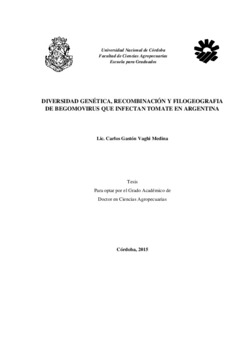| dc.contributor.advisor | López Lambertini, Paola María | |
| dc.contributor.author | Vaghi Medina, Carlos Gastón | |
| dc.date.accessioned | 2016-04-04T16:32:25Z | |
| dc.date.available | 2016-04-04T16:32:25Z | |
| dc.date.issued | 2015 | |
| dc.identifier.uri | http://hdl.handle.net/11086/2542 | |
| dc.description | Tesis (Doctor en Ciencias Agropecuarias)--UNC- Facultad de Ciencias Agropecuarias, 2015 | es |
| dc.description.abstract | El tomate es la hortaliza de mayor producción en la Argentina y esta afectado por
diversos patógenos entre los cuales se cuentan los begomovirus. Este género de virus
pertenece a la familia Geminiviridae y sus especies son transmitidos por la mosca blanca
(Bemisia tabaci Genn.). La mayoría de los begomovirus del Nuevo Mundo poseen dos
componentes genómicos, el DNA-A y el DNA-B. El objetivo del presente trabajo es
caracterizar la diversidad de begomovirus presente en infecciones simples y mixtas en el
cultivo de tomate en distintas regiones agroecológicas y evaluar sus características
evolutivas mediante análisis de filogenia, recombinación y filogeografía. Se amplificaron,
clonaron y secuenciaron 32 DNA-A y 23 DNA-B a partir de 155 y 17 muestras positivas
de plantas de tomate y de malezas respectivamente. Se identificaron las siguientes
especies: Tomato yellow vein streak virus (ToYVSV), Tomato rugose yellow leaf curl
virus (ToRYLCV), Solanum mosaic Bolivia virus (SoMBoV), Soybean blistering mosaic
virus (SbBMV), Tomato yellow spot virus (ToYSV), Sida Brasil virus (SiBrV). Además,
se reportaron y caracterizaron molecularmente por primera vez cuatro especies: Tomato
dwarf leaf virus (ToDfLV), Tomato mottle wrinkle virus (ToMoWV) y las especies nsp3 y
nsp4. Se estableció el primer mapa de distribución de especies de begomovirus en tomate
para Argentina siendo la región Norandina la más rica en especies y el ToYVSV la única
que se encontró en todas las regiones relevadas. Los análisis filogenéticos demuestran que
las especies identificadas pertenecen a tres grupos monofiléticos diferentes. Los análisis de
recombinación permitieron determinar cuatro especies recombinantes (ToMoWV,
ToRYLCV, nsp3 y nsp4), sus secuencias parentales y puntos de quiebre. Mediante análisis
filogeográficos se logró establecer la ruta de dispersión del ToYVSV desde Brasil y los
parámetros evolutivos como por ejemplo su alta tasa de sustitución. Se demostró una
compleja red de infecciones de begomovirus mediante la caracterización de especies
involucradas en infecciones mixtas y la riqueza de patrones de RCA-RFLP. La diversidad
de begomovirus que infectan tomate en Argentina se debe a la variedad en la composición
de especies involucradas en las infecciones mixtas y a la recombinación. En este escenario
¿Es la utilización de cultivares de tomate con resistencia-tolerancia a una especie de
begomovirus una estrategia de manejo viable para el control de estos patógenos? | es |
| dc.description.abstract | Tomato is the main vegetable crop in Argentina and is affected by several pathogens
including begomoviruses. This virus genre belongs to Geminiviridae family and its species
are transmitted by the whitefly Bemisia tabaci Genn. Most New World begomoviruses
have two genomic components, DNA-A and DNA-B. The objective of this work is to
characterize the diversity of begomovirus present in simple and mixed infections in tomato
crop in different agro-ecological regions, assessing their evolutionary characteristics by
phylogenetic, recombination and phylogeography analysis. They were amplified, cloned
and sequenced 32 DNA-A and 23 DNA-B from 155 and 17 positive tomato plants and
weeds samples, respectively. The following species were identify: Tomato yellow vein
streak virus (ToYVSV), Tomato rugose yellow leaf curl virus (ToRYLCV), Solanum
mosaic Bolivia virus (SoMBoV), Soybean blistering mosaic virus (SbBMV), Tomato
yellow spot virus (ToYSV), Sida Brasil virus (SiBrV). In addition, they were reported and
molecularly characterized for the first time four species: Tomato dwarf leaf virus
(ToDfLV), Tomato mottle wrinkle virus (ToMoWV) and nsp3 y nsp4 species. A map of
tomato begomovirus species distribution in Argentina was described determining the
Northern Andean as the most species-rich region and ToYVSV the only one species found
in all regions surveyed. Phylogenetic analyzes showed that the identified species belong to
three different monophyletic groups. Recombination analysis allowed determining four
recombinant species (ToMoWV, ToRYLCV, nsp3 and nsp4), their parental sequences and
break points. By phylogeographic analysis it was possible to establish the route of
ToYVSV dispersion from Brazil and the evolutionary parameters such as its high rate of
substitution. A complex network of infections begomoviruses was evidenced by the
characterization of the species involved in mixed infections and the richness of RCA-RFLP
patterns. Argentina tomato infecting begomoviruses diversity is due to the multiplicity of
species composition involved in mixed infections and their recombination. In this scenario,
is the use of tomato cultivars with resistance/tolerance to a particular begomovirus species
a viable management strategy to control these pathogens? | en |
| dc.format.extent | 203 h. : ilustración, tablas color | |
| dc.language.iso | spa | es |
| dc.rights | Atribución-NoComercial-SinDerivadas 2.5 Argentina | * |
| dc.rights.uri | http://creativecommons.org/licenses/by-nc-nd/2.5/ar/ | * |
| dc.subject | Tomate | es |
| dc.subject | Geminivirus | es |
| dc.subject | Evolución | es |
| dc.subject | Filogenia | es |
| dc.subject | Recombinación | es |
| dc.subject | Distribución geográfica | es |
| dc.subject | Argentina | es |
| dc.subject | Variación genética | es |
| dc.title | Diversidad genética, recombinación y filogeografía de bogomovirus que infectan tomate en Argentina | es |
| dc.type | doctoralThesis | es |





